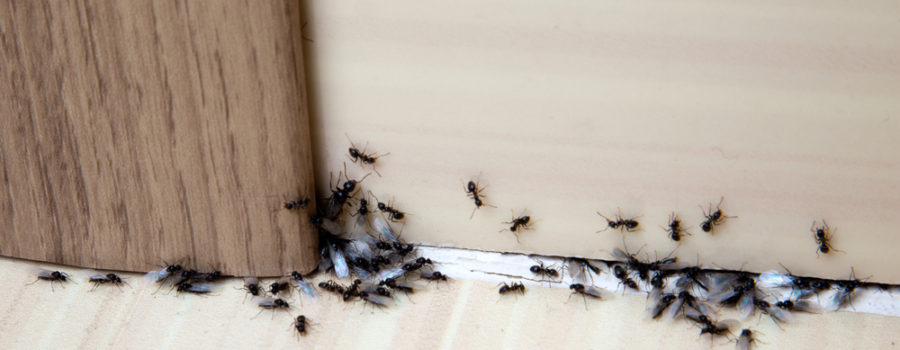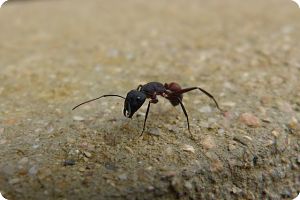Get rid of food and water sources
The first step in getting rid of ants is to get rid of their food and water. Cleanup and remove all food on counter tops, food crumbs or spills in cupboards, food on the floor, food in pet dishes, and food in trash cans. In addition to cleaning up, seal off all food in airtight containers. Plastic containers or plastic baggies work great for sealing off food from ants. Food, food crumbs, and food spills located anywhere in your home or business will generally attract ants. They especially like sweets. They like to eat. In addition, make sure there is no standing water, dripping water faucets, or leaking pipes. Ants go where they can find food and water. Ants cannot survive or will move somewhere else without food or water.
Clean up worker ant scent trails
Once food and water sources are removed, wipe down all areas where the ants have traveled with a household cleaner. The cleaner will get rid of the scent trails created by worker ants. The ants use these scent trails to find their food and water. We have found a paste of baking soda and water can be a great cleaner to help remove the scent trails. In addition, dry baking soda can be sprinkled along cracks and crevices to get rid of the scent. Another homemade cleaner that works well to remove the scent is a mixture of vinegar and water. Combine 50 percent vinegar and 50 percent water to form the solution. Spray it on and let it air dry.
Watch and wait once the cleaner is applied. Look for entry points.
Warning* Don’t use vinegar on natural stone counter tops, instead use a regular cleaner safe for Stone Countertops.
Remove debris on the outside of home or business
Most ants live and nest outdoors in large colonies under the ground. Some live next to foundations of buildings. And some live in the walls of your home or business. To discourage ants form living adjacent to your home or business, or in your walls, it is necessary to keep the outside of your property tidy. Cleanup and remove all debris, leaves, and mulch next to home or business. Cut back shrubs and trees – anything touching the building. This will eliminate cover for the ants. Also make sure there is no standing water around the perimeter of the building.
Seal cracks and crevices
Seal all cracks and crevices where ants can enter your home or business. Caulking works well. If cracks or crevices are found in cement then use mortar. Other commonly used sealing materials include putty, glue, or plaster. Some entrance points are easy to locate and some are well hidden. Some are so small they are nearly invisible to the human eye. Examine your home or business with a critical eye. Be thorough. Sealing your home or business off from ants takes time and diligence.
Commonly, ants will enter next to window frames, door frames, crawl spaces, garages, and through cracks in foundations. Pretty much anywhere there is a small opening.
Insecticides
Insecticides can be used to get rid of ants. There are many insecticides available. They come in the form of sprays, dusts, granules, and baits. The insecticides can be used in the yard, around the building’s perimeter, as spot spraying, or as a bait. If using insecticides please read and follow instructions carefully as insecticides are poisonous.
Spot spraying ants with insecticide will instantly kill them but offers only temporary relief. There are hundreds or even thousands more ants still hanging out in their colony. More ants will enter your home or business in a relatively short amount of time.
One of the most effective methods of using insecticides is spraying or dusting the outside parameter of the building on a regular basis. If consistent, this maintains an insecticide barrier that can inhibit ants from entering the home or business. The only problem with this method is it will not inhibit ants from entering from below the building. If there is an opening in the foundation, such as a crack or crevice, ants can still enter through the opening.
Another effective method is by using baits. Not all ants like the same foods so this can be a trial and error method. The ants will feed on the bait and take it back to their colonies. Baits are slow acting which gives the worker ant time to carry the bait back to the main colony. Baits need to be placed in areas where pets and children can’t reach them. Make sure when using the baiting method you have eliminated all other food and water sources.
Homemade ant bait
You can try a Borax based homemade ant bait. Again, please make sure this is not within reach of children and pets. It is poisonous.
Borax Ant Bait
1/2 Cup Sugar
1 1/2 Tablespoons Borax
1 1/2 Cup Warm Water
Some Cotton Balls
Mix the sugar, Borax, and warm water until well dissolved. Soak the cotton balls in the mixture. Put the Borax soaked cotton balls near where the ants travel.
Ants like sweets. The sugar in the homemade ant bait attracts the ants. The ants will then take the Borax soaked cotton back to their colony. When ants eat the borax bait, it disrupts their digestive system and slowly kills them. This slow kill time allows the ants to eat some of the bait and then head back to the colony to share with the rest of the ants and queen. This method takes a while to work.
Ant deterrents
Once the ant infestation is gone deterrents can be used. Some natural scents ants don’t like include:
Peppermint oil
Cinnamon
Cloves
Mint extract
Pepper
Salt
Paste made of citrus rind or peel (lemons, oranges, grapefruit)
Cucumbers sliced
Bay leaves
Baby powder
Diatomaceous earth
Give one or more of these scents a try. Put the scent next to where ants have entered your home or business.
Squish the worker ants
Worker ants, also known as scouts, are sent out by the colony to look for food and water. If you see a lone ant trolling around, squish it. Don’t let it live to go back and tell the rest of the ants it found food or water. The other ants will follow the scouts scent trail and soon an army of ants will be invading your home or place of business. Squish it, and do it fast. Remember it only takes one ant roaming around to start an ant infestation.
Ants can be hard to control
Once ants have established a colony they are hard to control and tuff to get rid of. Calling a professional is generally advised. Professionals have the knowledge, tools, and expertise to handle an ant infestation safely and effectively. A Pest Management Professional will conduct a thorough inspection and create a science based ant management plan. The plan will be tailored for your unique situation. Ant management plans include ant identification, recommendations for cleanup, sanitation, exclusion, as well as some insecticide use. All of it is important to use. It takes a comprehensive pest management plan to get rid of ants.
If you feel you need a professional pest management company to get rid of your ants, and to create a comprehensive plan to keep the ants away, please give Rocky Mountain Bird and Pest Solutions a call. We can help you get rid of ants and keep them from coming back.





Leave a Reply
Your email is safe with us.